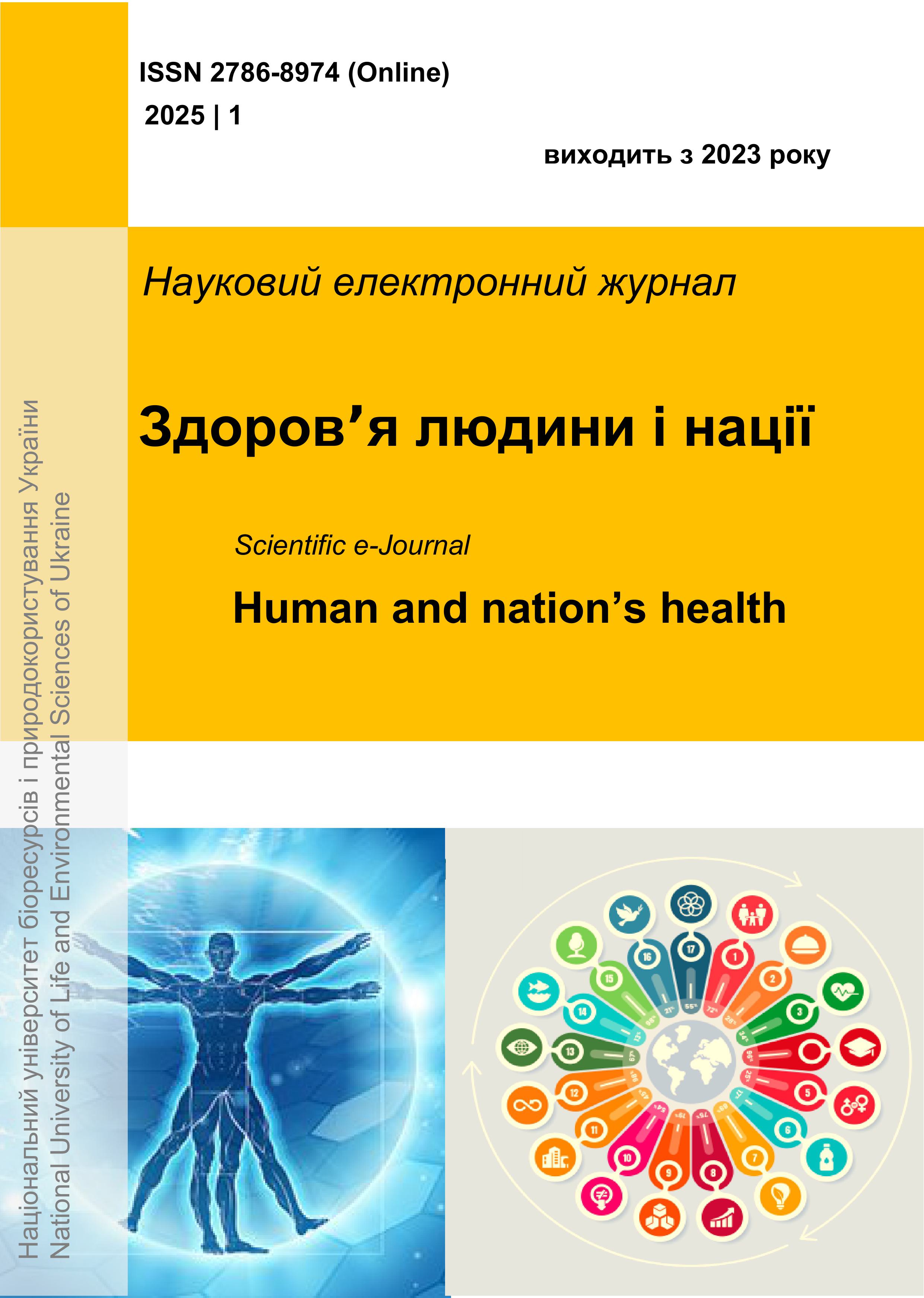HACCP PLAN FOR THE PRODUCTION OF POULTRY MEAT PRODUCTS
DOI:
https://doi.org/10.31548/humanhealth.1.2025.61Keywords:
HACCP, critical control points, natural meat semi-finished productsAbstract
The production of poultry meat products is considered one of the most promising aspects of ensuring food security in Ukraine. The expansion of the food market has provoked the possibility of food safety problems, which can lead to risks of negative impact on human health. The most effective solution should be the introduction of international standards and requirements for ensuring food safety. In order for Ukrainian enterprises to gain significant competitive advantages in the market, they should implement advanced methods and developments to ensure food safety.
The article is aimed at studying the practical application of HACCP principles in the production of natural semi-finished products from farm poultry meat. The production of products of the highest risk, which include semi-finished products from farm poultry meat, involves five preparatory stages for the development and implementation of a food safety management system.
The article describes the final product, in particular, its components, physico-chemical characteristics (temperature, etc.), processing methods (cooling), type of packaging, duration and storage conditions, as well as distribution mechanisms. A flowchart for the production of natural meat semi-finished products from turkey meat has been developed. The hazardous factors of each technological stage of the production of natural semi-finished products have been analyzed in detail; using the decision tree method, critical control points (CCPs) were identified and the HACCP plan was assessed and practical recommendations were given for corrective actions in CCPs during the production of natural semi-finished poultry meat products.
References
State Service of Ukraine on Food Safety and Consumer Protection - Development Strategy of the State Service of Ukraine on Food Safety and Consumer Protection. STATE SERVICE OF FOOD SAFETY AND CONSUMER PROTECTION. (2024) https://dpss.gov.ua/news/stratehiia-rozvytku-derzhprodspozhyvsluzhby-holovna-tema-zustrichi
Kolasińska D (2023). Ukraina z importera indyków stała się ich eksporterem. Czy stanowi dla Polski zagrożenie? topagrar.pl. https://www.topagrar.pl/produkcja-zwierzeca/ukraina-z-importera-indykow-stala-sie-ich-eksporterem-czy-stanowi-dla-polski-zagrozenie-2499220
Glevitzky, M., Glevitzky, I., Mucea-Ștef, P., Popa, M., Dumitrel, G.-A., & Vică, M. L. (2025). Integrated Risk Framework (IRF) – Interconnection of the Ishikawa Diagram with the Enhanced HACCP System in Risk Assessment for the Sustainable Food Industry. Sustainability, 17(2), 536. https://doi.org/10.3390/su17020536
Vasylenko G., Dorofeeva O., Holub B., Myronyuk G. (2011). A guide for small and medium-sized enterprises in the meat processing industry on the preparation and implementation of a food safety management system based on the HACCP concept. (Original published in 2011)
Yevlampiyeva, Y., Orynbekov D., Idyryshev B., Igenbayev A., Amirkhanov S., Shayakhmetova M. (2024). The effectiveness of implementing the HACCP system to ensure the quality of food products in regions with ecological problems. Frontiers in Sustainable Food Systems. https://doi.org/10.3389/fsufs.2024.1441479
Dima, A., Radu, E., & Dobrin, C. (2024). Exploring Key Barriers of HACCP Certification Adoption in the Meat Industry: A Decision-Making Trial and Evaluation Laboratory Approach. Foods, 13(9), 1303. https://doi.org/10.3390/foods13091303
Bal-Prylypko l., Antonenko, A., Tolok G., Brovenko T., Kryvoruchko M., & Gorkun a. (2024). Accreditation and prospects for the implementation of the HACCP system in food production. Measuring and computing devices in technological processes, (1), 111–116. https://doi.org/10.31891/2219-9365-2024-77-16
On approval of the Requirements for the development, implementation and application of permanent procedures based on the principles of the Food Safety Management System (HACCP), Order of the Ministry of Agrarian Policy and Food of Ukraine No. 590 (2015) (Ukraine). https://zakon.rada.gov.ua/laws/show/z1704-12#Text
On the basic principles and requirements for the safety and quality of food products. Official web portal of the Parliament of Ukraine. URL: https://zakon.rada.gov.ua/laws/show/771/97-вр#Text (access date: 21.01.2025).
Iannetti, Luigi & Neri, Diana & Santarelli, Gino & Cotturone, Giuseppe & Vulpiani, Michele & Salini, Romolo & Antoci, Salvatore & Di Serafino, Gabriella & Giannatale, Elisabetta & Pomilio, Francesco & Messori, Stefano. (2019). Animal welfare and microbiological safety of poultry meat: Impact of different at-farm animal welfare levels on at-slaughterhouse Campylobacter and Salmonella contamination. Food Control. 109. 106921. https://doi.org/10.1016/j.foodcont.2019.106921
Ishchenko, Yu. (2024). Improving the technology of poultry production in small and medium-sized enterprises based on the principles of the HACCP system. http://avianua.com http://avianua.com/index.php/statti-z-ptakhivnitstva/ tekhnologiya-ptakhivnitstva/ 54-robocha-prohrama-pnd-haccp (access date: 14.01.2025).
State Research Station of Poultry of the National Academy of Sciences of the Russian Federation. (2014). Poultry meat. General technical conditions. (DSTU 3143:2013).
Food Safety Handbook: A Practical Guide for Building a Robust Food Safety Management System. (2020). Washington, DC: World Bank. https://doi.org/10.1596/978-1-4648-1548-5
Tkachenko A. S., Basova Yu. O., Goryachova O. O. (2020). Implementation of the HACCP system for food market operators. Practical manual Poltava: PUET, 137
Symonova I., Galukh B., Drachuk U. and Basarab I. (2023). Improving the technology of marinated semi-finished poultry meat products. Scientific Bulletin of the Lviv National University of Veterinary Medicine and Biotechnology. Series: Food Technologies, 25 (99), 61-68. https://doi.org/10.32718/nvlvet-f9911
Downloads
Published
Issue
Section
License
Copyright (c) 2025 Human and nation's health

This work is licensed under a Creative Commons Attribution-ShareAlike 4.0 International License.
All materials are distributed under the terms of the Creative Commons Attribution 4.0 International Public License, which allows others to extend the article with acknowledgment of authorship and first publication in this journal.

